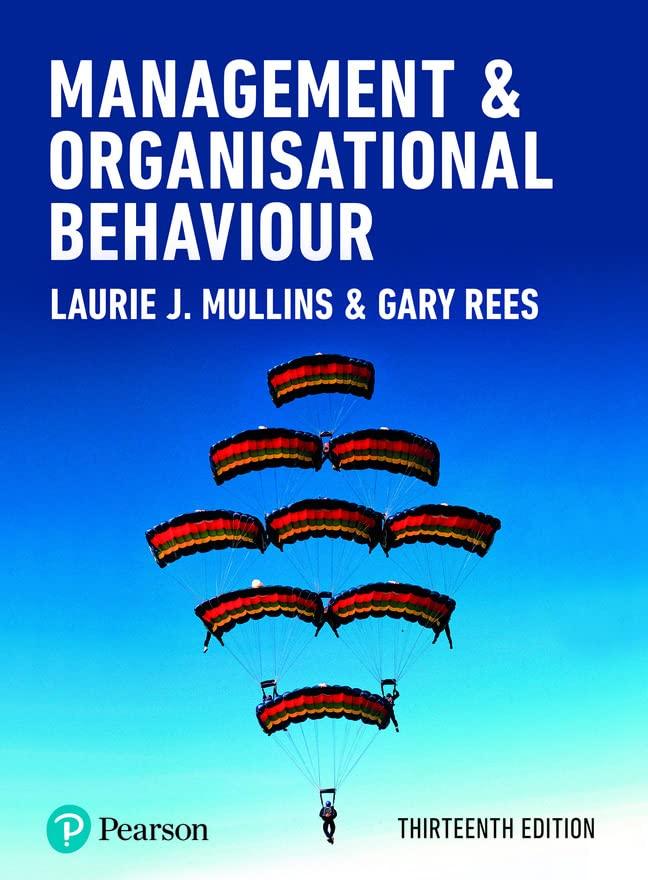An increasingly significant sector of the hospitality and leisure industry is that of the cruise sector. In
Question:
An increasingly significant sector of the hospitality and leisure industry is that of the cruise sector. In an ever-growing and continually-evolving cruise industry, the delivery of a memorable personal service experience is particularly significant as an integral part of organisational effectiveness.
Successful cruise management is a combination of travel agency, hotel and leisure activities, onboard entertainment and organised tours. It entails a complex and involved series of processes, both at sea and in different ports of call, quite unlike those experienced in most other business organisations.
Some particular factors to consider include, for example:
continual heavy guest occupancy and usage, with rapid turnover, mass entry and exit ‘people logistics’ – attending to the complex transportation needs of guests pre- and post-cruise, and the logistics of a broad variety of shore excursions in different locations a wide range of onboard activities and events throughout the day and evening the highest standards of safety and security, maintenance, logistics and tender operations relationships with Head Office, Technical Department, Port Authorities, Pilots etc.
expectations of high-quality cuisine, design and mix of menus, special dietary requirements health and hygiene, with large numbers of guests and crew in continual close contact crew resource deployment and rotation-planning, with the unavailability of additional agency or temporary staff, unlike land-based organisations. Need for flexible working practices in response to the demands of the business accommodating annual leave requirements, complex international flight arrangements for some crew members, and managing opportunities for time on shore change-over of crew at the end of contracts –
maintaining business continuity.
Cruising is associated with a high level of service delivery;
based on preconceived expectations, guests can be very demanding. Guest satisfaction is dependent to a very large extent on the people: in particular, the day-to-day contact with – and care and attention from – members of the crew; and also travel with fellow likeminded guests.
Different cruise ships tend to focus on a particular range of guests, for example younger people, families with children, more mature and perhaps less able people.
Although not exclusively, Fred. Olsen’s target clientele is guests over 55, and some itineraries stipulate adult travellers only.
Fred. Olsen Cruise Lines has a Norwegian heritage, but is a British based company, and dates back to 1848. It is one of the only family-run cruise lines in the world.
The company has stylish, smaller-sized ships, departing from seven regional UK ports. The ships have capacities between 935 and 1360 guests large enough to provide the facilities desired by guests, but small enough to enable a ‘closer’ exploration of a wide range of exciting destinations. Emphasis is on a comfortable, friendly atmosphere – delivered ‘with a smile’ – by caring and attentive crew. Guests are welcomed as individuals in a relaxed, familiar ‘home-from-home’ ambience.
Members of crew come from a wide and diverse range of cultures and backgrounds, with a majority from the Philippines, Thailand, Indonesia and India, especially among room stewards and restaurant staff.
There is also a noticeable cultural mix among top managers, from different religions, age groups and often different ways of working. The crew work long hours in often difficult and demanding conditions and are away from their homes and, in many cases young families, for up to nine months. Mixing socially is important.
Despite these different backgrounds, a noticeable feature is the strong, mutually-supportive team work across the Fred. Olsen fleet. Crew members are ready to help each other whenever needed, usually without direction from management. Supervisors are often seen helping out with routine duties to support their colleagues. A high number of Fred. Olsen crew members return to complete further contracts and have been engaged over many years with the company. In fact, Fred. Olsen has one of the highest staff retention rates of any cruise line, with some staff serving several decades with the company, and even generations of the same family working across the fleet.
Gratuities to crew members are an accepted custom throughout the cruise industry. Tips are a recognised feature of the reward system for good performance.
Questions
1. Explain particular features of organisational behaviour raised by this case study.
2. The company has a particular attraction for discerning, traditional guests, predominately in the 55-plus age bracket. What additional considerations do you think this creates for both crew and management?
3. What do you think are the most important factors that explain the high level of repeat guests on Fred.
Olsen cruise ships?
4. Discuss specific ways in which this case study draws attention to the importance of the people–
organisation relationship.
5. To what extent can a values-driven organisation (the Olsen Way) be a strategic differentiator when it comes to customer service and attracting and retaining existing customers? To what extent are their parallels with how the HR service should work, where colleagues are the ‘internal customers’?
Step by Step Answer:

Management And Organisational Behaviour
ISBN: 9781292422381
13th Edition
Authors: Laurie Mullins, Gary Rees





